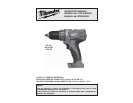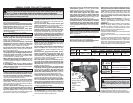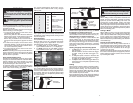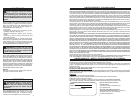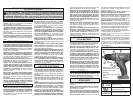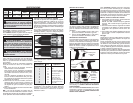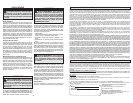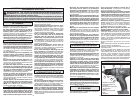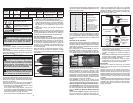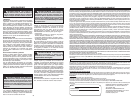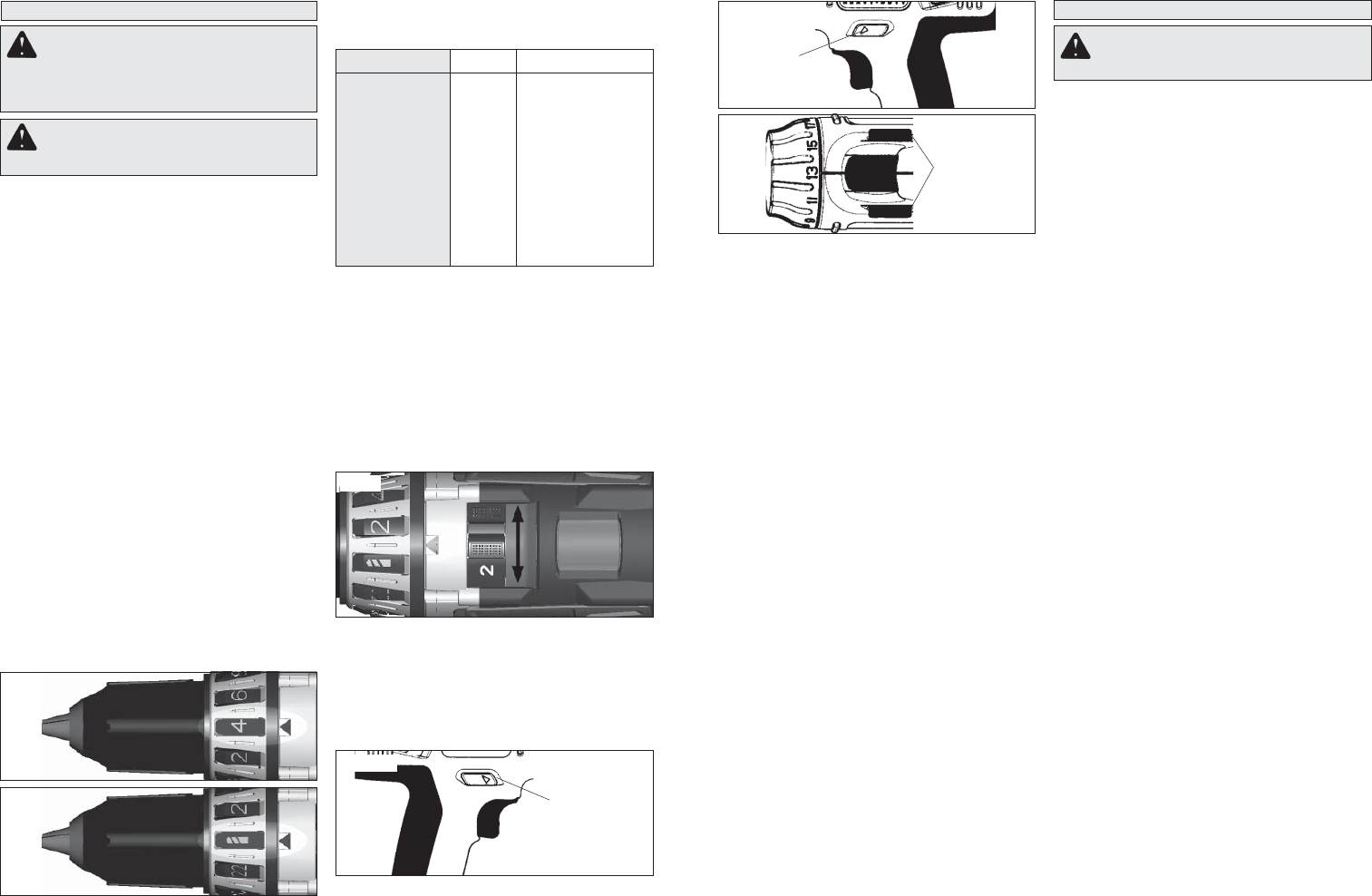
4
5
Using Keyless Chucks
This tool is equipped with a spindle lock. The chuck
can be tightened with one hand, creating higher grip
strengths on the bit.
Always remove the battery pack or lock the trigger
before inserting or removing bits.
1. To open the chuck jaws, turn the sleeve in the
counterclockwise direction.
When using drill bits, allow the bit to strike the
bottom of the chuck. Center the bit in the chuck
jaws and lift it about 1/16" off of the bottom.
When using screwdriver bits, insert the bit far
enough for the chuck jaws to grip the hex of the
bit.
2. To close the chuck jaws, turn the sleeve in the
clockwise direction. The bit is secure when the
chuck makes a ratcheting sound and the sleeve
can not be rotated any further.
3. To remove the bit, turn the sleeve in the coun-
terclockwise direction.
NOTE: A ratcheting sound may be heard when the
chuck is opened or closed. This noise is part of the
locking feature, and does not indicate a problem
with the chuck's operation.
Using the Adjustable Clutch
This tool has an adjustable clutch for driving differ-
ent types of screws into different materials. When
properly adjusted, the clutch will slip at a preset
torque to prevent driving the screw too deep and
to prevent damage to the screw or tool.
To adjust the clutch, turn the clutch adjusting ring
so that the desired setting (1-23) lines up with the
arrow on the motor housing, as shown.
NOTE: Because the settings shown in the table are
only a guide, use a piece of scrap material to test
the different clutch settings before driving screws
into the workpiece.
Selecting Speed
The speed selector is on top of the motor housing.
Allow the tool to come to a complete stop before
changing speeds. See “Applications” for recom-
mended speeds under various conditions.
1. For Low speed (up to 350 RPM), push the
speed selector to the left (“1” is displayed).
2. For High speed (up to 1400 RPM), push the
speed selector to the right (“2” is displayed).
Fig. 1
Fig. 2
Driving
Drilling
Low = 1
High = 2
Push in
for forward
Fig. 4
Fig. 5
Push in
for reverse
Fig. 3
Fig. 6
Push to
center
position to
lock trigger
Clutch Setting (in. lbs.) Applications
2
4
6
8
10
12
14
16
18
20
22
9.5
10.5
15.5
18.5
22
24.5
28.5
32
35
38.5
56
Small screws in
softwood.
Medium screws in soft-
wood or small screws
in hardwood.
Large screws in
softwoods. Medium
screws in hardwood or
large screws in hard-
wood with pilot hole.
The torque specifications shown here are ap-
proximate values obtained with a fully charged
battery pack.
OPERATION
WARNING Always remove battery
pack before changing or removing ac-
cessories. Only use accessories specifi cally
recommended for this tool. Others may be
hazardous.
WARNING To reduce the risk of injury,
wear safety goggles or glasses with side
shields.
For forward (clockwise) rotation, push in the control
switch from the right side of the tool (Fig. 4). Check
the direction of rotation before use.
For reverse (counterclockwise) rotation, push in the
control switch from the left side of the tool (Fig. 5).
Check direction of rotation before use.
To lock the trigger, push the control switch to the
center position (Fig. 6). The trigger will not work
while the control switch is in the center locked posi-
tion. Always lock the trigger or remove the battery
pack before performing maintenance, changing
accessories, storing the tool and any time the tool
is not in use.
Starting, Stopping and Controlling Speed
1. To start the tool, grasp the handle fi rmly and
pull the trigger.
NOTE: An LED is turned on when the trigger
is pulled. It will go off when the trigger is re-
leased.
2. To vary the speed, increase or decrease the
pressure on the trigger. The further the trigger
is pulled, the greater the speed.
3. To stop the tool, release the trigger. Make sure
the bit comes to a complete stop before laying
the tool down.
Drilling
Set the torque selector collars to the drill position.
Place the bit on the work surface and apply fi rm
pressure before starting. Too much pressure will
slow the bit and reduce drilling effi ciency. Too little
pressure will cause the bit to slide over the work
area and dull the point of the bit.
If the tool begins to stall, reduce pressure slightly to
allow the bit to regain speed. If the bit binds, reverse
the motor to free the bit from the workpiece.
Using Control Switch
The control switch may be set to three positions:
forward, reverse and lock. Due to a lockout mecha-
nism, the control switch can only be adjusted when
the ON/OFF switch is not pressed. Always allow
the motor to come to a complete stop before using
the control switch.
APPLICATIONS
Drilling in Wood, Composition Materials and
Plastic
When drilling in wood, composition materials and
plastic, start the drill slowly, gradually increasing
speed as you drill. When drilling into wood, use
wood augers or twist drill bits. Always use sharp
bits. When using twist drill bits, pull the bit out of the
hole frequently to clear chips from the bit fl utes. To
reduce the chance of splintering, back work with a
piece of scrap wood. Select low speeds for plastics
with a low melting point.
Drilling in Metal
When drilling in metal, use high speed steel twist
drills or hole saws. Use a center punch to start the
hole. Lubricate drill bits with cutting oil when drilling
in iron or steel. Use a coolant when drilling in non-
ferrous metals such as copper, brass or aluminum.
Back the material to prevent binding and distortion
on breakthrough.
Driving Screws and Nut Running
Drill a pilot hole when driving screws into thick or
hard materials. Set the torque selector collar to the
proper position and set the speed to low. Use the
proper style and size screwdriver bit for the type
of screw you are using.
With the screwdriver bit in the screw, place the tip of
the screw on the workpiece and apply fi rm pressure
before pulling the trigger. Screws can be removed
by reversing the motor.
WARNING To reduce the risk of electric
shock, check work area for hidden pipes
and wires before drilling or driving screws.



